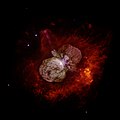Tugna:Eta Carinae.jpg
Apparence

Tiddi n azaraskan agi : 600 × 599 iferdisen n tugna. Tibuda nniḍen : 240 × 240 iferdisen n tugna | 480 × 480 iferdisen n tugna | 769 × 768 iferdisen n tugna | 1 025 × 1 024 iferdisen n tugna | 2 015 × 2 013 iferdisen n tugna.
Afaylu aneṣli (2 015 × 2 013 pixel, tiddi n ufaylu: 163 KB/KO, anaw n MIME: image/jpeg)
Amazray n ufaylu
Senned ɣef yiwen azmez d usrag iwakken ad ẓṛeḍ afaylu aken yella deg imir nni.
| Azemz/Ssaɛa | Aqmamaḍ | Iseggiwen | Amseqdac | Awennit | |
|---|---|---|---|---|---|
| Lux a | 18 Duǧember 2017 à 09:41 |  | 2 015 × 2 013 (163 KB/KO) | The NMI User | Reverted to version as of 14:14, 1 May 2008 (UTC) |
| 13 Meɣres 2017 à 14:45 |  | 3 000 × 2 998 (1,18 MB/MO) | Leogorgon | larger file size | |
| 1 Mayyu 2008 à 14:14 |  | 2 015 × 2 013 (163 KB/KO) | Vol de nuit | {{Information |Description=(NASA News Release) A huge, billowing pair of gas and dust clouds are captured in this stunning NASA Hubble Space Telescope image of the supermassive star Eta Carinae. Using a combination of image processing techniques (ditheri |
Aseqdec n ufaylu
Ulaḥedd seg isebtar sɛan azday ar afaylu-agi.
Aseqdec n ufaylu amatu
Iwikiyen-agi-nniḍen seqdacen afaylu-agi:
- Aseqdec ɣef da.wikipedia.org
- Aseqdec ɣef en.wikipedia.org
- Star
- Eta Carinae
- Wikipedia:Selected anniversaries/March 11
- Wikipedia:Today's featured article/March 2017
- Wikipedia:WikiProject Wikipack Africa Content/Wikipedia:Showcase
- Wikipedia:WikiProject WikiFundi Content/Eta Carinae
- Wikipedia:Today's featured article/requests/Eta Carinae
- Wikipedia:Today's featured article/March 12, 2017
- Wikipedia:Main Page history/2017 March 12
- Wikipedia:WikiProject WikiFundi Content/Wikipedia:Showcase
- Wikipedia:Main Page history/2022 March 11
- Wikipedia:Main Page history/2022 March 11b
- Wikipedia:Main Page history/2023 March 11
- Wikipedia:Main Page history/2023 March 11b
- User:2003 LN6/sandbox/Eta Carinae variable
- List of luminous blue variable stars
- Aseqdec ɣef en.wikiversity.org
- User:Marshallsumter/Radiation astronomy2/Visuals
- User:Marshallsumter/Radiation astronomy2/Violets
- Stars/Astronomy
- User:Marshallsumter/Radiation astronomy2/Violets/Quiz
- Stars/Sun/Astronomy/Quiz
- User:Marshallsumter/Radiation astronomy/Courses/Principles/Hourly 2
- User:Marshallsumter/Radiation astronomy/Courses/Principles/Final quiz
- Draft:Original research/Io/Quiz
- Titan/Quiz
- Stars/Solar systems/Quiz
- Moon/Quiz
- Earth/Quiz
- User:Marshallsumter/Radiation astronomy/Colors/Quiz
- Volcanoes/Io/Quiz
- Stars/Violets
- User:Marshallsumter/Radiation astronomy2/Stars
- Stars/Violets/Quiz
- Aseqdec ɣef es.wikipedia.org
- Aseqdec ɣef fr.wikipedia.org
- Aseqdec ɣef hi.wikipedia.org
- Aseqdec ɣef it.wikibooks.org
- Aseqdec ɣef la.wikipedia.org
- Aseqdec ɣef mk.wikipedia.org
- Aseqdec ɣef ms.wikipedia.org
- Aseqdec ɣef my.wikipedia.org
- Aseqdec ɣef oc.wikipedia.org
- Aseqdec ɣef ru.wikipedia.org
- Aseqdec ɣef sk.wikipedia.org
- Aseqdec ɣef sr.wikipedia.org
- Aseqdec ɣef th.wikipedia.org
Wali l’utilisation globale n ufaylu-agi.

